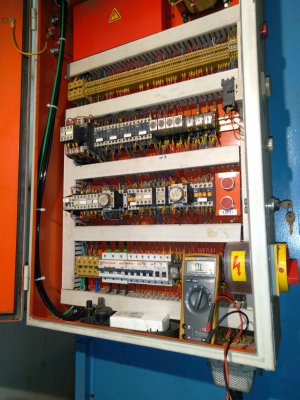Where do you see an indication of a DC circuit?
I see no rectifier bridge.
Some of the machines from the 40's and early 50's used 220 vac as control voltage!
Some contactor control circuits did use DC from a rectifier, but most I have seen have 24V AC coils, and the 24V AC was the voltage running through the E-Stop and control push-buttons. The motivation behind this design philosophy was to have all panels a user could touch be totally free of carrying anything wired to the live mains. E-Stops could also be all over the place. It had to be safe enough to put your hand on even when wet.
I still avoid high energy mains switchery directlly on components on any panel I touch.
Going "simple" for anything with a reasonable power inductive motor was not really an option if the switch contacts could weld up - and they do. Other arrangements are seen as "ghetto" hang-togethers. Small bench grinders do tend to have a straight mains switch. Drill presses also, but use a designed robust rotary, with really big fat contacts built to handle a bad time making disconnections.
DC circuits
DC circuits required pay attention to relay and contactor coils. Various hardware was "polarized", requiring connection to the correct polarity. It would involve diodes across the coils, to suppress the voltage spike. In normal connection, the doides would be reverse biased, and so be "not there" so far as the normal applied voltage was concerned. Upon switch-off, they would shunt the reverse EMF spike.
LINK -->
Why is there a diode connected in parallel to a relay coil?
Another reason for using DC was to allow a diode-based scheme for "driving out" of safety limit switches. It's a darn pain if one has inadvertently driven a machine into a limit switch, and be stranded there, unable to get it to move in the direction to recover. Very simple diode steering circuits get one out of this, but of course, need DC to work. Many factory machine circuits had two limit switch sets. The first could be recovered by simply driving out. The back-up required maintenance attention to discover the fail, because the machine might be driving lead-screws, and capable of rearing it up out of the floor! I preferred to remove a thread from near the end of the leadscrew, so things would run out of ability to move before things started bending.


